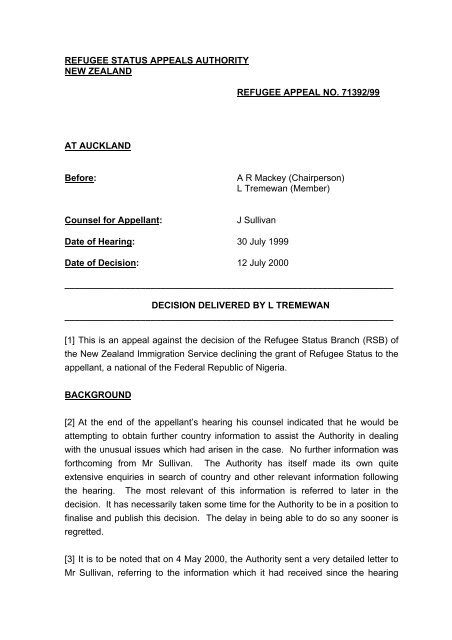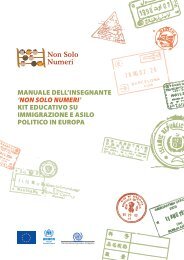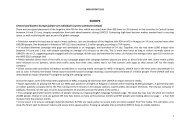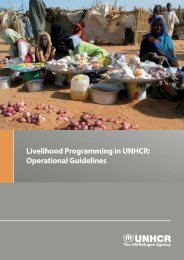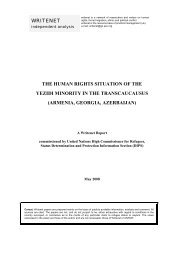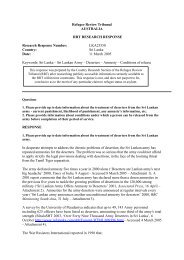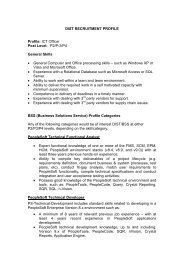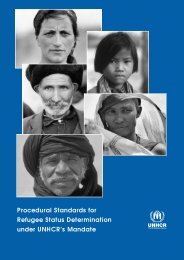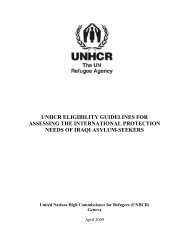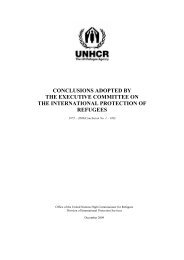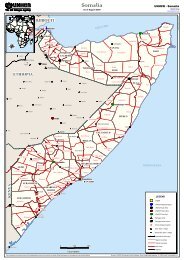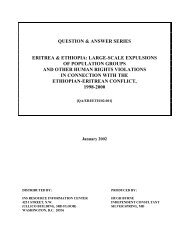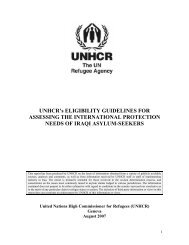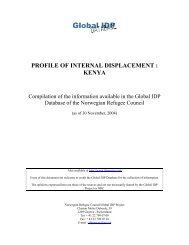REFUGEE STATUS APPEALS AUTHORITY - UNHCR
REFUGEE STATUS APPEALS AUTHORITY - UNHCR
REFUGEE STATUS APPEALS AUTHORITY - UNHCR
You also want an ePaper? Increase the reach of your titles
YUMPU automatically turns print PDFs into web optimized ePapers that Google loves.
<strong>REFUGEE</strong> <strong>STATUS</strong> <strong>APPEALS</strong> <strong>AUTHORITY</strong><br />
NEW ZEALAND<br />
AT AUCKLAND<br />
<strong>REFUGEE</strong> APPEAL NO. 71392/99<br />
Before: A R Mackey (Chairperson)<br />
L Tremewan (Member)<br />
Counsel for Appellant: J Sullivan<br />
Date of Hearing: 30 July 1999<br />
Date of Decision: 12 July 2000<br />
_________________________________________________________________<br />
DECISION DELIVERED BY L TREMEWAN<br />
_________________________________________________________________<br />
[1] This is an appeal against the decision of the Refugee Status Branch (RSB) of<br />
the New Zealand Immigration Service declining the grant of Refugee Status to the<br />
appellant, a national of the Federal Republic of Nigeria.<br />
BACKGROUND<br />
[2] At the end of the appellant’s hearing his counsel indicated that he would be<br />
attempting to obtain further country information to assist the Authority in dealing<br />
with the unusual issues which had arisen in the case. No further information was<br />
forthcoming from Mr Sullivan. The Authority has itself made its own quite<br />
extensive enquiries in search of country and other relevant information following<br />
the hearing. The most relevant of this information is referred to later in the<br />
decision. It has necessarily taken some time for the Authority to be in a position to<br />
finalise and publish this decision. The delay in being able to do so any sooner is<br />
regretted.<br />
[3] It is to be noted that on 4 May 2000, the Authority sent a very detailed letter to<br />
Mr Sullivan, referring to the information which it had received since the hearing
2<br />
which had a potential relevance to the case. The letter detailed the information<br />
received from the office of the United Nations High Commissioner for Refugees<br />
(<strong>UNHCR</strong>) (Nigeria) on 2 September 1999 and 2 May 2000 (which will be set out<br />
subsequently in this decision.) It also enclosed copies of the following:<br />
(a) Five decisions of the Immigration and Refugee Board of Canada<br />
Convention Refugee Determination Division (C.R.D.D.) (which are fully<br />
cited subsequently in this decision);<br />
(b) An Australian decision of the Refugee Review Tribunal (RRT) N96/12507<br />
(4 February 1998) and an appeal from that decision, of the Federal Court<br />
of Australia, in Vitalia Ananze Okere v Minister for Immigration &<br />
Multicultural Affairs [1998] 1171 FCA;<br />
(c) A decision of this Authority, referring to what is termed the Internal<br />
Protection Alternative (IPA) test, in Refugee Appeal No. 71684/99 (29<br />
October 1999).<br />
[4] Twenty one (working) days were allowed for Mr Sullivan to make further<br />
submissions on behalf of the appellant. Detailed submissions were subsequently<br />
received and have been fully considered by the Authority prior to appeal being<br />
determined.<br />
THE APPELLANT’S CASE<br />
[5] The appellant is a single man in his late twenties, who was born in a city in<br />
Edo State. He is the eldest of his parent’s five children. His two younger brothers<br />
and two younger sisters remain living in Nigeria with the appellant’s mother. His<br />
father is deceased.<br />
[6] The appellant was educated to a tertiary level; he studied, successfully, for<br />
two years at University, towards a business qualification. He did not complete that<br />
qualification due to financial difficulties.<br />
[7] The appellant’s mother worked selling meat in a large local market place.<br />
His father, who died in May 1998 (and whose death was a precursor to the<br />
appellant leaving Nigeria, for reasons which will be shortly explained), worked in<br />
the military until his retirement in about 1980. Because the appellant’s father was,
3<br />
as a result of his occupation, required to spend most of his time living away from<br />
home at the bases at which he was performing his service, this meant that for the<br />
appellant’s growing up years he and his siblings were primarily under the care and<br />
influence of his mother, his father only being at home when on leave. There was<br />
one year, however, when the family left home to live with the appellant’s father,<br />
when he was based in the north of Nigeria, however the appellant’s mother found<br />
it too difficult to live there with her children and she and the children soon returned<br />
home to Edo State.<br />
[8] The appellant’s mother is a strict Catholic who raised her children as<br />
Catholics. The appellant continues to actively practise his faith.<br />
[9] The appellant’s father on the other hand was, in the appellant’s description,<br />
a “pagan” who was the eldest (or “senior”) son of his own father, who was a<br />
member of the Ogboni cult. As a result, when the appellant’s paternal grandfather<br />
died, in 1980 (the same year that the appellant’s father retired from the military)<br />
the appellant’s father, as the senior son, was obligated to assume his father’s cult<br />
title. He became deeply committed and involved with the Ogboni cult from that<br />
time. In the appellant’s perception, he “changed” in that regard. The appellant<br />
himself, on the death of his father would also be required to take up the patrilineal<br />
title, and assume Ogboni status, according to the rules of the cult. The appellant<br />
also understands that their general family title also had an additional role within the<br />
cult, concerning matters of discipline.<br />
[10] The appellant recalled that when he was five or six years old, his father took<br />
him out in the family vehicle, apparently to visit friends. Once at the destination,<br />
however, he was blindfolded by his father who took him by the hand and told him<br />
not to be afraid. After being taken along some kind of path, the appellant was<br />
brought into a large structure and his blindfold was removed.<br />
[11] The appellant described in considerable detail (which need not be repeated<br />
here) what he saw and experienced at that time. In summary, there were a<br />
number of males present performing various rituals, which the appellant found<br />
distressing. It is also noteworthy that he received, during one ritual, cuts to the<br />
backs of his hands, in a particular pattern. Some other young boys who were<br />
present also had this happen to them. The appellant's cuts were then “treated” in<br />
some way, and have remained like tattoos on the backs of his hands since then.<br />
The appellant understood the tattoos denoted cult status. The tattoos on the
4<br />
backs of the appellant’s hands were seen by the Authority members at the<br />
hearing.<br />
[12] The appellant was told by his father that as he was his father’s senior son,<br />
he would grow to take his father’s title upon his death. The appellant was,<br />
however, terrified by what he had experienced and although his father threatened<br />
him not to say anything about what had taken place, he told his mother what had<br />
happened. His mother made it clear that she did not approve of the rituals to<br />
which the appellant had been exposed and told him that he should remember his<br />
Catholic beliefs, pray and fast.<br />
[13] Although the appellant's father had accordingly initiated him into the cult at<br />
a young age, as already mentioned it was not until the appellant’s paternal<br />
grandfather later died in 1980, that the appellant’s father became more fervently<br />
involved in the cult’s activities. As it coincided with his retirement from the military<br />
he had the time to devote himself to the cult. The details of that involvement were<br />
not disclosed to the appellant’s mother, due to the obligations of secrecy imposed<br />
by the cult (and also because of her disapproval of the cult).<br />
[14] When the appellant was about 10, after his father had taken his own<br />
father’s title, he again took the appellant to the place where the Ogboni rituals<br />
were practised. As the appellant was then regarded as an initiated member he<br />
was not blindfolded. His father explained to him that he was required to come to<br />
witness other younger boys being initiated. On this occasion he was however<br />
marked again himself, this time on the outside of each of his upper arms. These<br />
markings remain. Although the appellant found this incident upsetting it was not<br />
as deeply traumatic as when he had first been initiated.<br />
[15] In 1987, when the appellant was about 16, his mother separated from his<br />
father, taking the children with her. This was because she had discovered certain<br />
Ogboni ritual garments in the house belonging to her husband. Although she had<br />
well known that her husband was a cult member who had taken his father’s title,<br />
she had hoped that he was not as deeply involved in the cult as he clearly was<br />
and she could not tolerate this any longer. After their separation, the appellant’s<br />
father remarried and had two more children, a son and a daughter. These<br />
children, being the appellant’s half brother and half sister, have remained living<br />
with their mother, following the death of the appellant’s father (which event will be<br />
described shortly).
5<br />
[16] The appellant explained to the Authority how, as a teenager he had spoken<br />
to his father about his extreme concern at the prospect of taking his father’s cult<br />
title upon his death. His father reiterated what the appellant already knew, namely<br />
that it was not a matter over which he had any choice. His father also referred to<br />
him as being childish and that in the fullness of time he would come to realise that<br />
taking up his title was his obligation. He also made it clear that he would risk his<br />
life if he attempted to avoid his responsibilities in this regard. The appellant<br />
however, regarded the cult’s practises as satanic and “against the will of God”, and<br />
against what his mother had taught him.<br />
[17] The appellant described to the Authority in detail the various paraphernalia<br />
which denoted membership of the cult. He indicated that many people of status in<br />
Nigerian society, including within the police and military forces, wear such items so<br />
that they may be recognised as having the special status of the cult membership.<br />
Membership brings with it advantage, privilege and protection which is exercised<br />
between the members in terms of one another. The appellant stated that it is well<br />
known that cult membership is relatively commonplace and that its rules are<br />
strictly adhered to. The emphasis placed on secrecy, however, with dire<br />
consequences for those who break this rule, cause to make it a very secretive<br />
organisation in terms of knowledge of its inner workings being made known to the<br />
outside world.<br />
[18] Due to his Christian beliefs the appellant does not fear curses being placed<br />
upon him by cult members, but he does fear that his life would be at risk from the<br />
members themselves should they discover that he has breached the rules of<br />
secrecy. Moreover he considers himself to be a risk for failing to meet his<br />
obligation in terms of taking up his father’s title, as will be shortly explained.<br />
[19] In the mid -1990s (although he is not able to be accurate as to the date), a<br />
close friend of the appellant’s, A, refused to take his father’s Ogboni title, following<br />
his father’s death. About five months after his father’s funeral, A was kidnapped<br />
and his body was later found at the side of a road. A post-mortem examination<br />
was reported to have revealed that he had died from poisoning. No other findings<br />
or convictions have ever followed as a result of A’s death. The appellant stated<br />
that it was commonly understood that A was killed as a result of his refusal to take<br />
up his father’s title.
6<br />
[20] Also in the mid-1990s, the appellant’s mother was offered the opportunity to<br />
be chair-lady of the Butcher’s Association at her market, a position of some<br />
importance. She would have received payments from the members of the<br />
association over the term of her office, and enjoy certain buying privileges.<br />
However, she would first be required to become a member of the Ogboni women’s<br />
group. The appellant explained to the Authority that the women’s groups are<br />
separate and that one can seek to join both the men’s and women’s groups even if<br />
there is not (in the case of the men) a requirement of joining. However, his mother<br />
declined the opportunity to take up the chair-lady’s position because of her<br />
unwillingness to join the Ogboni cult. There were no repercussions as a result;<br />
she simply did not have the privileges which she would have had otherwise.<br />
[21] The appellant did also state that around this same period of time, his<br />
mother had a civil dispute with another local woman, over a small piece of land to<br />
which they each considered they had title. A court case was held with the ruling<br />
being made in favour of the other woman. In the appellant’s view this was<br />
because the other woman was a member of the Ogboni women’s group and was<br />
therefore in a position of greater influence than his mother.<br />
[22] In another incident, the appellant’s younger brother E had been involved in<br />
a small car accident, having borrowed the car from a man who was Ogboni.<br />
Following the accident the owner demanded compensation for the damage, but<br />
the amount sought was more than the cost of the repairs. The appellant’s mother<br />
simply paid the amount demanded, without challenge or comment, as she did not<br />
want any conflict or problems with an Ogboni member.<br />
[23] On 26 March 1998, the appellant’s father died unexpectedly, following a car<br />
accident. The appellant moved to his father’s house, as is culturally required in<br />
such circumstances, and cared for his father’s wife and children while making the<br />
arrangements for his father’s funeral. This was to be held on 20 April 1998, being<br />
a month following the death. However, after a few days, some Ogboni cult<br />
members approached the appellant and reminded him of the expectation that he<br />
would take his father’s Ogboni title on the day of his father’s funeral. The<br />
appellant had previously had it in the back of his mind that it might be possible for<br />
the eldest son of his father’s second marriage to be a substitute for him, however it<br />
emerged that this was not regarded as acceptable. The appellant asked if he<br />
could have a few days to think matters over. He was told that there was nothing to<br />
think about as he was required, quite simply, to see through his obligations.
7<br />
[24] The appellant believed from what he knew, that the final stages of the<br />
initiation may involve his being required to consume some part of his father’s body.<br />
[25] After the Ogboni men had left, the appellant immediately returned to his<br />
mother’s house and spoke with her and her brother. It was decided that the<br />
appellant should leave Nigeria immediately and arrangements were made in this<br />
regard. The appellant had a valid passport which he had obtained in 1992<br />
although he had never travelled out of Nigeria.<br />
[26] The appellant left Nigeria on 10 April 1998, and travelled to Israel where he<br />
was able to obtain some work for a few months. He did make an enquiry as to<br />
whether he could formally seek refuge in Israel but was told that such avenues<br />
were not available. He now accepts that the information he obtained in this<br />
regard, from a university student, may have been unreliable though he had<br />
accepted it as accurate at the time. Eventually, he made arrangements to leave<br />
Israel, travelling on a friend’s South African passport. He intended to come to New<br />
Zealand as he had been told that it was visa free for a person travelling on such a<br />
passport and that he could possibly obtain refuge here.<br />
[27] The appellant arrived in New Zealand on 28 October 1998 and applied for<br />
refugee status at the airport. The authorities here however refused to issue him<br />
with a permit upon his arrival, pursuant to s.128 of the Immigration Act 1987, as<br />
amended by the Immigration Amendment Act 1999. The appellant was<br />
subsequently detained at an Auckland prison and an RSB interview was held there<br />
on 4 November 1998. The appellant was not legally represented at that time.<br />
[28] After some time the appellant was released from custody (the Authority<br />
does not know precisely when). The RSB decision to decline the appellant’s<br />
refugee status application was issued on 12 March 1999 (although the decision<br />
itself incorrectly bears the date 12 March 1998), and the appellant subsequently<br />
filed a notice of appeal in respect of that decline decision.<br />
[29] The appellant stated that he fears returning to Nigeria as he believes that<br />
his life is at risk there as a result of his not having taken up his father’s Ogboni<br />
title. He considers that this is a most serious matter and that it would only be a<br />
matter of time before he would suffer retribution in the same way that his friend A<br />
did. He considers that he is unable to receive protection from, for example, the<br />
police as members of the police are Ogboni themselves. In any event they are
8<br />
unable to provide effective protection to the appellant in any meaningful way given<br />
the degree of risk and the general circumstances of his situation.<br />
[30] The appellant maintains that even if he were to leave the city where he has<br />
lived his life (and where he is well known and could easily be eventually located)<br />
but moved elsewhere, still this would not afford him any effective protection for a<br />
number of reasons. Firstly, the appellant claims that members of the Edo tribe<br />
(who are easily identifiable as such, by name, language and facial markings) are<br />
more likely to be cult members. Further, the backs of his hands and upper outer<br />
arms have markings/tattoos which the appellant stated are Ogboni markings which<br />
would serve to identify him as having that association.<br />
[31] The appellant also explained in some detail to the Authority how Ogboni<br />
recognise one another and make special efforts to befriend and associate with one<br />
another, giving each other what advantage they can, and protecting one another.<br />
Even if he went to some remote part of Nigeria where he was not personally<br />
known or recognised, the appellant stated that he would soon be identified as an<br />
Ogboni. It would then become a matter of some suspicion that he was not acting<br />
in the expected manner nor taking opportunities to visit the shrine. Eventually, he<br />
would be properly “found out“ and in the meantime would live a life of fear and in<br />
hiding.<br />
[32] The appellant's previous experiences have had an impact on him. He often<br />
ruminates about his situation and experiences, and also suffers nightmares,<br />
although he draws some comfort from his faith.<br />
[33] Since the appellant has been in New Zealand, he has only made one brief<br />
telephone call home, to a neighbour’s house, speaking with two of his siblings.<br />
There was no particular news to report at that time. However, when the appellant<br />
had first left Nigeria and was earning wages in Israel he was then able to make<br />
more regular telephone calls. He was told then that his next youngest brother, E<br />
had not been attending college as he was ‘lying low’, fearful that he would be<br />
targeted by Ogboni members wanting information as to the appellant’s<br />
whereabouts. E had, however then returned to college to finish his education.<br />
Although nothing untoward had been reported as having happened to any of the<br />
family members they were said to be fearful for the appellant and for themselves,<br />
worried that they might be approached by cult members.
THE ISSUES<br />
9<br />
[34] The Inclusion Clause in Article 1A(2) of the Refugee Convention relevantly<br />
provides that a refugee is a person who:-<br />
"... owing to well-founded fear of being persecuted for reasons of race, religion,<br />
nationality, membership of a particular social group or political opinion, is outside<br />
the country of his nationality and is unable or, owing to such fear, is unwilling to<br />
avail himself of the protection of that country; or who, not having a nationality and<br />
being outside the country of his former habitual residence, is unable or, owing to<br />
such fear, is unwilling to return to it."<br />
[35] In terms of Refugee Appeal No. 70074/96 (17 September 1996), the<br />
principal issues are:<br />
(a) Objectively, on the facts as found, is there a real chance of the<br />
appellant being persecuted if returned to the country of nationality?<br />
(b) If the answer is yes, is there a Convention reason for that persecution?<br />
[36] Because the issue of internal protection arises in this case, the decision of<br />
this Authority in Refugee Appeal No 71684/99 (29 October 1999) requires a third<br />
and final issue to be addressed:<br />
(c) Can the appellant genuinely access domestic protection which is<br />
meaningful?<br />
In particular:<br />
(a) In the proposed site of internal protection, is the real chance of<br />
persecution for a Convention reason eliminated?<br />
(b) Is the proposed site of internal protection one in which there is no<br />
real chance of persecution, or of other particularly serious harms of<br />
the kind that might give rise to the risk of return to the place of origin?<br />
(c) Do local conditions in the proposed site of internal protection meet<br />
the standard of protection prescribed by the Refugee Convention?
10<br />
ASSESSMENT OF THE APPELLANT’S CASE<br />
[37] Before assessing the issues outlined above, it is first necessary to make an<br />
assessment of the appellant’s credibility.<br />
[38] The Authority accepts that the appellant’s account has been truthfully given.<br />
While many aspects of the appellant’s narrative may seem bizarre we found his<br />
evidence as to his past experiences to generally have a ‘ring of truth’ about it. His<br />
demeanour was consistent with his evidence. His evidence at the hearing was<br />
also materially consistent with statements which he has previously given at the<br />
Refugee Status Branch interview and at the airport. The account has also been<br />
generally consistent with country information separately obtained by the Authority.<br />
[39] We now turn to the issues to be addressed.<br />
[40] Before turning to the first of the issues framed, namely whether there is a<br />
real chance of the appellant being persecuted if returned to Nigeria, it is necessary<br />
to refer to some country and other relevant information.<br />
COUNTRY INFORMATION<br />
[41] It is relevant to refer to some comprehensive country information before<br />
summarising the approach which has been adopted in respect to the issues<br />
arising in this case by other similar jurisdictions (particularly as the Authority has<br />
not previously dealt with a case involving these issues).<br />
[42] At the end of the appellant's hearing, the Authority sent a request for<br />
information to the <strong>UNHCR</strong> (Nigeria) concerning the Ogboni cult. The request<br />
indicated that the Authority was interested to know any information about the<br />
present strength and status of the group, its current practises/activities and what<br />
risks are posed by the cult to those who do not support it or who antagonise its<br />
members. The response, received on 2 September 1999, firstly referred to some<br />
earlier information dated January 1994, which was said to still be current. That<br />
general information is first set out below (verbatim):<br />
“Ogboni Fraternity<br />
AAA) A/M society said to have always been sustaining spiritual power behind<br />
Yoruba Kingdom.
11<br />
BBB) Reformed Ogboni Fraternity (ROF) alleged established within the church<br />
by Reverend Ogunbiyi about 70 years ago to encourage elites who were<br />
members of Ogboni Society and felt church was for the poor, to attend<br />
church. Group said to possess tremendous mysterious powers including<br />
necromancy, instilling fear into non-members.<br />
CCC) Members initiated after certain rituals, members protect each other under<br />
any circumstances, enjoy special privileges in society and participate in<br />
various rituals. Group is alleged to oppress non-members within<br />
communities.<br />
DDD) Round about 1977, when activities of group allegedly became notorious,<br />
the then Federal Military Govt issued ultimatum for members of ROF in<br />
civil service to either repudiate membership or leave the service. Some<br />
members far advanced in hierarchy of group chose to resign appointments<br />
as civil servants rather than repudiate membership.<br />
EEE) Another group - Ogboni Aborigine, a derivative, is alleged to be and<br />
possesses more diabolical powers than the ROFG.<br />
FFF) Membership of the two societies is voluntary and open to all ethnic groups.<br />
Presently there is no government proscription of their<br />
activities/membership non (sic) is anyone known to have been penalised<br />
for being a member (<strong>UNHCR</strong> Lagos).”<br />
[43] The <strong>UNHCR</strong> report then referred to the specific query raised by the<br />
Authority, relating to the question of risks posed by the Ogboni, as follows:<br />
“… persecution (by the group) arises only when member withdraws membership,<br />
which is seen by group as a violation/betrayal of oaths sworn to by such members.<br />
Such cases (if any) are treated as any other civil matter, and govt. only intervenes<br />
if it involves physical violence.”<br />
[44] There has been a considerable amount of information written about the<br />
Ogboni, however much of it dates back to the 1960s, when an academic, Emeritus<br />
Professor Peter Morton-Williams (then of the University of Ulster, now retired)<br />
specialised in studying the cult. An Immigration and Refugee Board<br />
Documentation Centre (IRBDC) (Ottawa) DIRB Response to Information Request<br />
NGA 8434 (7 May 1991) (Refworld) cites references relating the historical origins<br />
of Ogboni:<br />
“... According to anthropologists Susan Druker-Brown of the University of<br />
Cambridge, Michelle Gilbert of Yale University and Smith College, and Karin<br />
Barber of the University of Birmingham, Emeritus Professor Peter Morton-Williams<br />
of the University of Ulster is considered as one of the leading experts on the<br />
Yoruba Ogboni cult, specifically the Ogboni of the Oyo region of Yorubaland.<br />
However, Professor Morton-Williams’ publications on the subject were written<br />
mainly in the early 1960s.<br />
Yorubaland formerly contained several hundred chiefdoms and occupied most of<br />
what is now western Nigeria. Each chiefdom had an Alafin, the Oba or King,<br />
which, in Oyo region, was checked by the Oyo Misi (Council of State) which in turn<br />
was restrained by the chiefdom’s Ogboni. The “Ogboni is a secret and ritually
12<br />
united corporation of political and religious leaders and its special priests” (Morton-<br />
Williams 1960, 364)…<br />
…The word Ogboni is derived from gbo to be old and eni, a person (Morton-<br />
Williams 1960, 368). The cult itself worshipped the “earth spirits” and its judicial<br />
functions were mainly concerned with the settling of disputes in which “blood had<br />
been shed on the earth” (Morton-Williams 1960, 366). According to J.S. Eades,<br />
Lecturer of Social Anthropology at the University of Kent at Canterbury, the cult’s<br />
“wider political significance lay in the fact that it provided an opportunity for the<br />
leading elders of the town to meet in guaranteed secrecy” (Eades 1980, 98).<br />
The initiation into the Ogboni goes as follows:<br />
Initiation rites are performed at entry into the senior grade only, with a further rite<br />
marking induction into a titled office. There is no initiation into the grade of juniors,<br />
this being really little more than a state in which potential membership of the higher<br />
grade is recognised. It indicates that an individual is a patrilineal descendant of an<br />
Ogboni and, because Ogboni are still recruited from the descent group, some<br />
spiritual protection is extended to him. It also entails the duty of contributing to the<br />
funeral expenses of lineage Ogboni members. Boys may accompany their fathers<br />
into the “ileadi”, when no sacrifices are to be made and when no sacred images<br />
shown, but are threatened with death if they mention anything seen or heard there<br />
(ibid., 368).<br />
Secrecy was an important part of the Ogboni cult and according to Morton-<br />
Williams, the cult “has the right to impose sanctions over those who reveal its<br />
secrets and procedures to others” and these “sanctions are imposed not only to<br />
guard secrets but also to protect agreements reached at the Ogboni meetings”<br />
(Morton-Williams 1960, 362, 366).<br />
Sanctions tend to vary according to the perceived offences but details about the<br />
sanctions such as the type, the mode and the enforcement are scarce…. Most<br />
Ogboni rituals involved the sacrificing of animals, but according to Morton-Williams,<br />
some rituals used to include forced suicide, poisoning, human sacrifice and<br />
cannibalism. For example, if an Oba embarked on a course of action of which the<br />
Ogboni disapproved, he would have been coerced into committing suicide (Ibid.,<br />
367). If someone in the Ogboni cult broke the code of secrecy, “the Ogboni will try<br />
to poison him, or to paralyse him by casting a spell on his footprints” (Ibid., 370).<br />
Concerning a major issue which deeply divided the Ogboni and following a majority<br />
decision, a human sacrifice would be offered to Ikuku-oro and Aiwo-oro (“Spirit of<br />
Death” and “Unseeing Spirit”). Morton-Williams does specify that he had never<br />
been given an account of a particular occasion when such a sacrifice was made<br />
but he does add that he is “satisfied that it would be regarded as a compelling<br />
sanction even in political issues” and that “in comparison to their neighbours to the<br />
east or to the west, the Yoruba were not a bloodthirsty people, and regarded<br />
human sacrifice as very awesome” (Ibid., 370).<br />
In another ritual, after a Yoruba Alafin died in the Oyo region, his successor would<br />
be given the dead Alafin’s heart to eat and later he would be handed the skull of<br />
his predecessor, “which has been filled with a corn gruel which he must drink”<br />
(Ibid., 371).<br />
During a telephone interview on 4 May 1991, Professor Morton-Williams stated<br />
that according to him, the Ogboni had lost its judicial role in today’s society and<br />
government although it still commands some fear and exerts some influence but<br />
not to the extent it did in the past…<br />
Morton-Williams tends to agree with Mrs Maureen Eke, a Nigerian Ph.D. student<br />
and the Associate Outreach Coordinator of the African Studies Centre at Michigan
13<br />
State University, when she states that the main purpose of any society like the<br />
Ogboni claiming the use of rituals involving human sacrifice and cannibalism is to<br />
deter inquiries into their affairs; to promote a sense of mysticism and a sense of<br />
the occult and to build themselves up in the eyes of the impressionable in order to<br />
keep some sort of influence and control over the people.<br />
Professor Morton-William’s added that in general the Ogboni have always been a<br />
very tolerant society which, rather than clinging to its exclusivity, tended to accept<br />
into its ranks most faiths as long as the members conformed with the Ogboni’s<br />
ways.<br />
Morton-Williams also added that he heard that a new group, the Reformed Ogboni<br />
Cult, now existed and that although he had very little information on the subject, he<br />
believes that the occult stories surrounding this Reformed Ogboni Cult are being<br />
circulated in order to enhance its mysticism and therefore achieve a greater<br />
influence and control over the targeted individuals and groups.”<br />
[45] The Authority has considered various articles describing ongoing tensions<br />
between the Christian churches in Nigeria and the cult. Many of these referred to<br />
situations where cult members have pervaded the church hierarchy and other<br />
sections of society, to the highest levels. For example, an editorial piece in The<br />
Ethnic News Watch, “The Week”, dated 24 November 1997, referred to events in<br />
mid 1996 when Olu Holloway, described as a “leading light” within the Methodist<br />
Church of Nigeria died. He had also, however, been the supreme head of the<br />
Reformed Ogboni Fraternity (ROF). On 11 May, while his funeral was taking<br />
place, the Church members were physically ousted by cult members who overtook<br />
the proceedings. The scenario was repeated two months later at the funeral on 23<br />
July, of Mofolorunso Olutola-Dada, son of Moses Dada, reputed to be the first<br />
indigenous Methodist minister in Africa. He was also, however, the Abore (chief<br />
priest), of the Reformed Ogboni Fraternity.<br />
[46] A notable case, however, referred to in the article from The Ethnic News<br />
Watch concerned Adetokunbo Ademola, knight of the British Empire, Nigeria’s first<br />
indigenous chief justice while the longest serving supreme head of ROF (from<br />
1952-1993). The article stated:<br />
The crisis of secret societies, particularly the Ogboni, the most prominent in<br />
Nigeria’s Christendom, has not been confined to the Methodist church. Indeed, the<br />
Ogboni Fraternity, later refined to become the Reformed Ogboni Fraternity, was<br />
founded by Anglican clergymen more than 70 years ago….The relationship<br />
between Ogboni and Christianity….blows into the open at periods of transition<br />
between the burial of a departing supreme head and the installation of a new one.<br />
Such was the case of Adetokunbo Ademola, knight of the British Empire, Nigeria’s<br />
first indigenous chief justice and the longest serving supreme head of ROF (1952-<br />
1993). The case of Holloway who succeeded Ademola was different only to the<br />
extent of the intensity of the furore which marked his departure.<br />
…[T]he Methodist church did take a decision at its Ikot-Ekpene conference in<br />
August 1996, spelling out 25 organisations it classified as secret societies and the
14<br />
penalties for membership, both for the laity and the clergy. The year before, the<br />
Anglican communion had taken a stand against all such organisations as the ROF,<br />
Freemasonry and AMORC at a meeting in Awka.<br />
Despite the pronouncements on the matter, the spirit of cultism does not appear to<br />
be waning in the older churches. On the contrary, those designated by the<br />
churches as belonging to these secret societies are becoming defiant, insisting that<br />
the clergy was not in any position to inflict penalties on them, least of all, excommunication.<br />
In a nutshell, the battle is about to burst forth again.<br />
When the war of cult and christianity was being waged in 1996 following<br />
Holloway's demise, we did a cover on the story which attracted considerable<br />
interest among Christians in particular, and Nigerians in general. The expectation<br />
is that the battle would have to come to a logical conclusion. More than a year<br />
after and a lot of canonical rumblings later, the issue is here once more, prompting<br />
us to send a team of reporters into the field...”<br />
[47] The Authority notes that the above article referred to an earlier lengthy<br />
article on the “War of Cult and Christianity” also published on 5 August 1996, by<br />
The Ethnic News Watch “The Week”. In that article, subtitled “Trouble in God’s<br />
House”, the difficulties faced by the Christian churches in light of the threat by the<br />
Ogboni was described as the “most acute dilemma facing the church in Nigeria<br />
today”. It stated, inter alia,<br />
... Before the Methodist, the Catholic Church had tasted of the bitter cup of cultic<br />
conflict. A prominent Catholic, Adetokunbo Ademola, a Knight of the British<br />
Empire and first indigenous Chief Justice of Nigeria has been the longest serving<br />
supreme head of the Ogboni fraternity. He was the Olori Oluwo from 1952 till his<br />
death in January 1993, a period of some 40 years. He was president of the<br />
Catholic Friendly Society, CFS, a group of professionals whom some of the<br />
worshippers saw as constituting the ROF wing of the Catholic hierarchy.<br />
Upon Ademola’s death, the Catholic Church was in quandary on what to do over<br />
his burial rites. The church had always held that members of the secret societies<br />
should not receive holy communion and at death should not be accorded the<br />
normal Catholic burial follows this order…..<br />
….Months later, an inter-denominational memorial service was organised on May<br />
14, 1993, for the repose of Ademola’s soul. Held at the Ake palace in Abeokuta,<br />
Ogun State, the service attracted the clergy, high chiefs, and traditional rulers. The<br />
Ogboni Fraternity was notably represented. In a sermon, S.C. Sopein, the primate<br />
of the United Spiritual Church of Nigeria took a swipe at Nigerians critical of the<br />
Ogboni fraternity as a secret cult of evil-minded persons. He said the fraternity,<br />
like other religious sects, seeks to get people to see the light and lead them to<br />
obtain everlasting joy. In his estimation, the life of late Ademola was the best thing<br />
that ever happened to Nigeria.<br />
Not many will agree. To a magnitude of Nigerians, the Ogboni fraternity conjures<br />
evil secrecy, terror, nepotism, perversion of justice, fetishism and even ritual<br />
murders. None could have been more aware of this negative image than Ademola<br />
himself. In an interview with Vintage People three years before he passed on,<br />
Ademola tried to put some shine on the society he headed from 1952 to 1993. He<br />
said the ugly image of the fraternity was due to the tendency of the African to look<br />
down on anything indigenous while putting a disproportionate premium on things<br />
foreign. He equally saw it as arising from ignorance. Even so, his response<br />
sometimes raised more questions than answers. Hear him: “What do you want
15<br />
me to say about Ogboni? I won’t discuss it with you. You are not a member.<br />
People can think what they like about the fraternity but only members can know<br />
what goes on in there. There is nothing to talk about”.<br />
That is precisely the point. Official reaction against secret societies in recent<br />
memory came during the Murtala Muhammed regime. Quite appropriately,<br />
Theophilus Danjuma, the then chief of army staff, opened the government assault.<br />
At the army command in Ibadan, he released a fusillade targeting secret societies<br />
as “a formidable threat to the stability of the army”. He bristled: “They are nothing<br />
but a protection racket invariably with the sole motive of avoiding and neutralising<br />
justice”.<br />
By 1977, the federal government clamped down on “these societies whose<br />
proceedings are kept secret, whose minutes are not kept and whose list of officers<br />
and members is not published or made known”. The government’s indictment was<br />
scathing. According to it, “these are societies whose members are under oath,<br />
obligation or threat to promote the interests of other members (whether these<br />
interests are legitimate or not) and whose members are compelled to come to one<br />
another’s aid under all circumstances without regard to merit, fairplay, or justice<br />
and to the detriment of the legitimate expectations of non-members”.<br />
Though the demonization could have been referring to such other societies as the<br />
AMORC and the Freemasons, it fitted perfectly the public perception of the Ogboni<br />
Fraternity. Such perceptions were somewhat confirmed when the government<br />
ordered public officers to renounce their membership of these societies or face<br />
dismissal and when some military governors, notably in Benin, drafted soldiers to<br />
seal up the temples of the Ogboni, Freemasons, and the Rosicrucians. The<br />
Obasanjo administration followed this up by outlawing public servants’ membership<br />
of secret societies in the 1979 constitution.<br />
Following this development, members of the ROF literally went underground,<br />
preferring to lie low. The organisation popped up again in 1984 during its 70 th<br />
anniversary. It decided to use the occasion for image polishing by issuing a<br />
manifesto attempting to deny the toga of secrecy woven around it...<br />
That did not seem to help. Almost a decade later, the ROF was again compelled<br />
to advertise itself to the public following the religious controversy over Ademola’s<br />
burial and the election of Holloway to succeed him as the Olori Oluwo….”<br />
[48] Another article from The Economic News Watch, “The Week”, dated 24<br />
November 1997 entitled “Evidence of Things Not Possible”, included the following<br />
passages:<br />
“As Abidodun Ade-tiloye Archbishop and head of the Church of Nigeria, (Anglican<br />
Communion) embarked on a pastoral visit to the Benin Diocese a couple of months<br />
back, one issue weighed heavily on the different tunes played in the minds of the<br />
visiting prelate’s mind and that of his hosts the parishioners of St. James Anglican<br />
Church, Benin, Edo State. Of utmost concern to Adetiloye was how to stamp out<br />
the growing membership and influence of secret cult members among the flock.<br />
To achieve the object, the man of God decided to borrow a leaf from the Methodist<br />
Church of Nigeria whose leadership had introduced a new oath of allegiance “to<br />
Jesus Christ alone” to be administered on all members of the church under the<br />
leadership of Sunday Mbang, Primate of the church in Nigeria, the 35 th biennial<br />
conference of Methodists had risen last year with a number of proclamations<br />
including oath-taking following a virulent attack by evangelicals to curb cultism<br />
within the Methodist fold. (sic)
16<br />
With his pastoral work over in Benin, Adetiloye then invited the elders of the<br />
Church to lead the congregation by example by swearing to the oath which had<br />
identical wordings as those employed by the Methodist Church: “I declare that my<br />
allegiance is for Jesus Christ alone and I hereby denounce publicly the secret cults<br />
that I belong to and by the power and grace of God, I pledge that I will never go<br />
back to it (sic).” If the Anglican head in Nigeria thought this was a straightforward<br />
ritual, he was grossly mistaken. The reaction of some of the elders of St. James<br />
Anglican Church, Benin City, that Sunday morning jolted him. While some of the<br />
elders bluntly refused to denounce publicly their membership of secret cults, others<br />
stayed away from service that morning, claiming that they had either taken ill or<br />
travelled out of town. Though the deviant church elders were roundly ... booed and<br />
jeered by other parishioners, Adetiloye jetted back to Lagos without satisfactorily<br />
fulfilling his task of bringing the erring flock back to christian rectitude.<br />
Still the Anglican prelate is not alone in his predicament. He has good company in<br />
Mbang, his opposite number at the Methodist church. Things got to a head (sic)<br />
last month when the Primate reportedly threatened to arraign cult members before<br />
the Methodist Church Conference, described as the highest ruling council of the<br />
Methodist Church of Nigeria, when the body meets next month. In a story<br />
published in The Guardian of Tuesday, October 14, this year, the Primate was<br />
reported to have said that (t)hose found guilty would be excommunicated in what<br />
was clearly a desperate strategy in the lingering battle between christianity and<br />
cultism ...<br />
... But the conflict between the leadership of the churches and the cultists would<br />
appear to have just begun, given the spirited efforts being made by the cultists “to<br />
arrest some misconceptions in the minds of the people,” as Falowa, the Olori-<br />
Apena of Ogboni, put it in a press conference he addressed in Lagos last week.<br />
…..He was to stretch the enigmatic nature of the ROF …. when he sought to<br />
explain the motive force of the society. "We are not evil at all," he said, and then<br />
added in another breath: "We are just merciless in our decisions. We do not put<br />
sentiment and pity into our decisions. Once a decision has been taken, it must be<br />
carried out." And equally mysterious was Falowa's enumeration of some of the<br />
benefits of the Ogboni fraternity to the larger society. Exemplifying with Sagamu, a<br />
local government headquarters in Ogun State, the ROF spokesman said his<br />
society, more than the police or even Operation Wedge, the state government<br />
special anti-robbery squad, has been responsible for the near-absence of armed<br />
robbers in the town. The people of Sagamu, he said, had never experienced the<br />
kind of peace they now enjoy, adding that it is only the people of the town that can<br />
explain how the robbers that were caught were killed. Falowa boasted: "If the<br />
government can give the Ogbonis just six months to handle crime cases in Nigeria,<br />
you will not hear anything of robbers again"<br />
Though the ROF frequently lays claim to the possession of some higher social<br />
good, their officials often fall short of speaking directly about their activities as<br />
Falowa does. The result is public perception of ROF as personifying evil secrecy,<br />
terror, nepotism, perversion of justice and ritual murders. Such close-mouthedness<br />
was displayed by Adetokunbo Ademola, Nigeria's first indigenous chief justice, who<br />
as a staunch Catholic was equally the longest-serving Olori Oluwo of ROF from<br />
1952 to 1993 when he died. In an interview with Vintage People in 1990, he bluntly<br />
refused to oblige his interviewer on the group's mode of worship. "I won't discuss it<br />
with you. You are not a member," the longest reigning Olori Oluwo had said then.<br />
….<br />
Kukah of the Catholic Secretariat has little faith in the efficacy of the various<br />
measures being put in place by the churches to arrest the menace of the cultists.<br />
Describing the societies as "alternative rungs in the ladder of social mobility," the<br />
reverend father believes members are drawn into them more by a describe to<br />
satisfy some of those needs which the system could not otherwise guarantee. (sic)
17<br />
Making specific example of cultism in schools, Kukah reckons that it is usually the<br />
need by the individual to seek alternative avenues to belong when the society<br />
seems to have rejected him that often drives him into belonging to societies and<br />
clubs which seem capable of gratifying those needs. To arrest the situation, Kukah<br />
urges that the system, both in schools and the outside world, be made responsive<br />
enough to guarantee the benefits individuals go to seek in secret societies.<br />
A food for thought for Mbang, Adetiloye and other leaders of the religious<br />
organisations currently enmeshed in a war of attrition with secret cult members in<br />
their folds.”<br />
[49] The Authority has also referred to an article in The Economist (31 July<br />
1999) “Nigeria: Reaching for your machete: Does the spreading violence in<br />
Nigeria presage a wider social breakdown?” This refers to “ethnic clashes, village<br />
feuds”, and what are called “cult killings on university campuses”. It describes, for<br />
example, eight students at Obafemi Owolowo University in south-western Nigeria,<br />
having allegedly been murdered by members of a “campus cult”. The involvement<br />
of university students in cults was also reported in a reference from The<br />
Documentation, Information and Research Branch, Immigration and Refugee<br />
Board (DIRB), Ottawa, request for information (NGA 13942) (concerning a<br />
crackdown and arrest of members of the ‘Buccaneer Confraternity Cult’) (dated 18<br />
May 1993) (<strong>UNHCR</strong> Refworld). It stated, inter alia:<br />
“... the Xinhua General Overseas News Service also mentioned arrests of students<br />
at some institutions of higher learning for their involvement in secret societies<br />
(Xinahua 12 June 1991). As well, the Ogboni Cult Fraternity which had been<br />
officially banned by the Nigerian government, was reported to be operating in<br />
secrecy and engaging in satanic practices (IRBDC 16 March 1992).”<br />
Decisions from other jurisdictions:<br />
[50] The issues raised in the present case have been previously canvassed in<br />
some other jurisdictions, notably Australia and Canada. A summary of cases<br />
located by the Authority from those jurisdictions follows.<br />
Australia:<br />
[51] In a decision of the Refugee Review Tribunal (RRT) N96/12507 (4 February<br />
1998), the Tribunal accepted the credibility of an account presented by an<br />
applicant who had been selected through local custom to lead a cult (unnamed).<br />
He had refused due to his Christian beliefs, and faced the prescribed penalty of<br />
death as a result. It was accepted that he had a well founded fear of persecution.
18<br />
[52] The Tribunal however dismissed the claim on the basis that there was no<br />
Convention ground. The Tribunal stated, at 4 (citing from Kuldip Ram v. Minister<br />
for Immigration and Ethnic Affairs (1995) FCR 565):<br />
“…[I]t is the motivation of the persecutor, in inflicting harm, which determines<br />
whether the harm amounts to persecution within the meaning of the Convention.<br />
In order to be considered Convention persecution, the harm must be motivated, on<br />
the part of the persecutor, by a desire to harm the applicant for reason of his or her<br />
race, religion, nationality, political opinion or membership of a particular social<br />
group”.<br />
[53] Later in the decision the Tribunal stated (citing Jahazi v. MIEA (1995) 61<br />
FCR 293):<br />
“It is not sufficient that there be a bare causal connection between the harm<br />
feared and a Convention reason - it is not sufficient that the Applicant follows a<br />
particular religion, or belongs to a particular kinship group, and also faces<br />
persecution. There must be a relevant causal connection between the harm<br />
feared and the Convention category so that it can be said that the harm is<br />
motivated by and directed at the Applicant because of that Convention ground”.<br />
[54] The Tribunal concluded by stating that the Applicant faced persecution<br />
because of what he had done as an individual, refusing to lead the followers of<br />
traditional religion in his village, “not for reason of his race or religion”. It also<br />
dismissed the applicability of whether there could be a Convention ground of<br />
particular social group, noting that such a group had to be:<br />
“a cognisable group within their society….Moreover, the characteristic or element<br />
which unites the group cannot be a common fear of persecution. In other words,<br />
the group must not be defined by the persecution.”<br />
[55] The decision in N96/12507 (ibid.) was however successfully appealed to the<br />
Federal Court of Australia. In the decision, Vitalia Ananze Okere v Minister for<br />
Immigration & Multicultural Affairs [1998] 1171 FCA, Branson J referred to Article<br />
31 of the Vienna Convention on the Law of Treaties:<br />
“ which calls for a holistic approach in which “[p]rimacy is to be given to the<br />
written text of the Convention but the context, object and purpose of the treaty<br />
must also be considered”.<br />
[56] The Court referred to the need to apply “common sense to the facts of each<br />
case”, citing a decision of Mason CJ in March v Stramare (1991) 171 CLR 506, at<br />
515). With regard to that decision, it was said:<br />
“I appreciate that the March v Stramare test is a common law test of causation,<br />
but having regard to the principles of interpretation of treaties referred to above, it<br />
reflects, in my view, an appropriate approach to the construction of this aspect of<br />
Article 1A(2) (of the Refugee Convention)….
19<br />
….The RRT was required in this case, in my view, to ask itself whether, applying<br />
common sense to the facts which it accepted, the applicant had a well-founded<br />
fear of persecution, the true reason for which is his religion.<br />
It follows from the above analysis that I reject the contention made on behalf of<br />
the respondent that Article 1A(2) of the Refugee Convention is to be construed as<br />
excluding from the protection afforded…[by the Convention] persons who have a<br />
well-founded fear of persecution which is motivated not directly for reason, for<br />
example, of their religion, but only “indirectly” for reason of their religion.<br />
According to this contention, for example, persons who have a well-founded fear<br />
of persecution for reason of their refusal to work on the Sabbath could not be<br />
found to have a well-founded fear of persecution for reason of their religion; the<br />
persecution feared by them would be related to their refusal to work and not to<br />
their religion.<br />
Professor Hathaway in his book The Law of Refugee Status (1991) at p. 148<br />
expresses the view that “indirect prevention of religious practice is sufficient to<br />
establish a claim to refugee status”. He refers to the decision of the Immigration<br />
Appeal Board (Canada) in Tomasz v Gozdalski (decision M87-1027X, 23 April<br />
1987)…<br />
..History supports the view that religious persecution often takes “indirect” forms.<br />
To take only one well known example, few would question that Sir Thomas More<br />
was executed for reason of his religion albeit that his attainer was based on his<br />
refusal to take the Succession Oath in a form which acknowledged Henry VIII as<br />
head of the Church of England.”<br />
[57] Branson J set aside the decision at first instance, and referred the matter<br />
back to the Refugee Review Tribunal for reconsideration. That reconsideration did<br />
not eventuate however, for unrelated reasons.<br />
[58] Before leaving this section of the decision, the Authority notes in passing<br />
that New Zealand is a State Party to the Vienna Convention on the Law of Treaties<br />
(23 May 1969). That Convention did not come into force until 1980, subsequent to<br />
the Refugee Convention, however it has been accepted by the International Court<br />
of Justice that the relevant article (Article 31) merely restates the customary<br />
international law position (see Territorial Dispute Case (Libya v. Chad) [1994] ICJ<br />
Reports para 41).<br />
Canada:<br />
[59] The Authority has located five relevant decisions of the Immigration and<br />
Refugee Board of Canada Convention Refugee Determination Division (C.R.D.D.).<br />
[60] In B. (I.F.) (Re) [1991] CRDD No. 355 No. M91-01381 (10 July 1991), the<br />
claimant was a Christian whose father was a high priest of the Ogboni cult. He<br />
was summoned by the cult to initiate his daughter as a priestess, and the claimant
20<br />
was told that if she refused she would be killed. The claimant attempted to get<br />
help from within her church, and from the police who advised that there was<br />
nothing that they could do and refused to take her complaint. The police officers<br />
with whom she dealt referred to the existence of cult members occupying “virtually<br />
all important positions in the judiciary, army, police and even in the policy-making<br />
body of the country”. She left the country with the assistance of her church and<br />
claimed refugee status.<br />
[61] The Board, however, in dismissing the claim, referred to country information<br />
(which the Authority notes includes much the same information which it has<br />
sourced) and stated:<br />
“Based on documentation cited above, we believe that the obligation to be initiated<br />
into the Ogboni society is limited to sons, or perhaps the eldest son, although the<br />
documentation does not say this, of an Ogboni priest. We believe that the risk is<br />
minimal - if any- that a daughter, even the eldest, and surely not a young daughter<br />
of twenty-three, the age of the claimant, be obliged to be initiated into the Ogboni<br />
society (sic)”.<br />
[62] The Tribunal rejected the credibility of the account on the above basis. It<br />
also stated:<br />
“Were she …a male descendent, we could consider the well-foundedness of a fear<br />
of persecution. However, the claimant, the eldest descendent, is a female<br />
descendent and documentation does not support her claim to belonging to a<br />
particular social group….”<br />
[63] In G. (E.C.) (Re) [1991] CRDD No. 1211 No. U91-05670 (21 November<br />
1991), the Tribunal dismissed the claim of a Christian male who had refused to<br />
offer a human sacrifice as directed by Ogboni cult members when his father had<br />
fallen ill. He claimed to have been beaten and escaped. His father had<br />
subsequently died, resulting in the claimant having the obligation to take his<br />
father’s title.<br />
[64] In this decision, there is no reference to whether the account presented by<br />
the claimant was accepted as credible. The Tribunal appears to have focused on<br />
the comment of retired Professor Morton-Williams (in a telephone interview) which<br />
opined that the Ogboni “had lost its judicial role in today’s society and government<br />
although it still commands some fear and exerts some influence but not to extent<br />
that it did in the past”. The Tribunal considered that :
21<br />
“There is no indication in the documentary evidence that the Ogboni society or any<br />
other secret society has infiltrated the rest of Nigeria or that its activities are<br />
tolerated or widespread.”<br />
[65] It also went on to state that:<br />
“Nor is there any indication that the government of Nigeria tolerates actions of a<br />
criminal nature by any secret society. Thus neither the Ogboni, nor for that matter<br />
any other secret society, can violate the laws of Nigeria with impunity.”<br />
[66] It referred to the presumption of state protection stating that there was no<br />
indication that any barriers existed to prevent the claimant from seeking protection<br />
elsewhere in Nigeria.<br />
[67] Similarly, in the case of K.(X.X.) (Re.) [1993] CRDD No. 390 No. U93-<br />
08591 (21 December 1993), the Tribunal was faced with a claim from male<br />
Christian who had refused to take up his father’s position within the Ogboni cult.<br />
His business had been burnt down by Ogboni. In this decision, as in the<br />
previously cited decision, no reference was made with respect to the credibility of<br />
the account presented but no adverse comments were made in that regard. The<br />
Tribunal referred to an DIRB Response to Information Request NGA 10364 (16<br />
March 1992) which referred to Ogboni rituals as being illegal and amounting to a<br />
criminal offence. When this had been put to the claimant he had responded by<br />
saying that “people do them anyway”. The Tribunal also referred to the same<br />
IRBDC Response to Information Request (ibid) Ogboni as “a satanic cult officially<br />
banned by the government”. The claimant had stated that the documentation had<br />
been written in a way to protect the Ogboni and that “many of the top people”<br />
(within the police or other agencies from whom one might seek help) were Ogboni.<br />
[68] On the facts the Tribunal found that the claimant had not sought help and<br />
that it was not unreasonable for him to have sought the protection of the state,<br />
particularly when his business was burnt down. The Tribunal considered that the<br />
claimant would be protected by the state from the harm feared, and also<br />
commented that he had failed to establish the presence of a Convention ground in<br />
his case.<br />
[69] In E. (L.L.) (Re) [1992] CRDD No. 584 No. M91-07499 (3 April 1992) the<br />
Tribunal granted refugee status to a male, Christian, lawyer from Nigeria, who had<br />
encountered problems at the death of his father, an Ogboni cult member. The<br />
claimant had been required to take his father’s title, stating that initiation of the<br />
eldest son at the death of his father (if it has not already occurred during the
22<br />
father’s lifetime) is compulsory at the time of the father’s death. Membership<br />
would have required him to engage in abhorrent practises. He referred to the<br />
issue of the Government ban (of the cult) but stated that the enforcement of the<br />
law was not possible. He stated “they make claim to changes to alleviate pressure<br />
on them and make themselves appear more acceptable, but they still do the same<br />
things”. He also named individual and group members of the cult who held<br />
positions of importance within society, and referred to lawyers who were members<br />
of the cult getting “special dispensations from Judges who are also members. If<br />
you want protection, you have to join”. He stated that cult members were “known<br />
to kill people who cross them. People who cross them have disappeared”, and of<br />
having heard of situations where people tried to refuse initiation into the Ogboni<br />
society and were not seen again.<br />
[70] The claimant stated that he could not have lived elsewhere in Nigeria<br />
without people knowing, having relatives in every major city in Nigeria.<br />
[71] The Tribunal accepted the credibility of the account given, considering it<br />
was consistent with available country information. With regard to the issue of state<br />
protection the Tribunal referred to country information suggesting that:<br />
“…[W]hile the agent or agents of persecution are not state sanctioned, the agent<br />
or agents of persecution appear to be a group over which the state has little<br />
control, because of the myths surrounding the group as well as lack of effective<br />
control”.<br />
[72] The Tribunal ultimately accepted that the claimant faced a well-founded fear<br />
of persecution across Nigeria, placing particular weight on the fact that he was a<br />
member of the Nigerian bar. It was considered that he therefore had some profile<br />
in that regard.<br />
[73] It found that the applicable Convention ground was ‘a particular social<br />
group’. In a brief analysis, which did not actually specify the particular social<br />
group, it simply referred generally to this concept being “supported by the<br />
testimony and the documentation which confirmed that initiation into the Ogboni<br />
Secret Society is by descent”.<br />
[74] In S. (H.O.) (Re) [1992] CRDD No. 351 No. C92-00088 (21 September<br />
1992), the Tribunal dismissed a claim brought by a female claimant , making<br />
adverse findings about the credibility of the claim which really in any event<br />
amounted to a family dispute.
Is there a chance of the appellant being persecuted if returned to Nigeria?<br />
23<br />
[75] In turning to the appellant’s risk of persecution if returned to Nigeria it is<br />
necessary to consider the relevant country information. Taking a general overview<br />
of the information, and, placing weight on the fact that the Ogboni cult clearly goes<br />
to some lengths to adopt secrecy about itself and its rituals resulting in a situation<br />
where there is consequently a very limited amount of reliable information available<br />
in this regard, we accept that what the appellant has told us that he fears as<br />
generally reliable.<br />
[76] We accept that there would be a real chance if the appellant returned to his<br />
home area that his life would be at risk at the hands of Ogboni members as a<br />
result of his failure to fulfil his obligations. He is well known there, having lived<br />
there all of his life. It appears from the evidence that his father also had some<br />
degree of local prominence within the cult. We accept that the Ogboni relies on<br />
continuity as a means of ensuring its continued existence, and that fear and<br />
mysticism are central tenets of its belief system. The <strong>UNHCR</strong> information to which<br />
we have already referred, while not entirely supportive of the appellant’s case, did<br />
note that risks arise when a member (of the cult) withdraws membership. It stated<br />
that such “is seen by (the) group as a violation/betrayal of oaths sworn”.<br />
[77] Thus we accept that the appellant faces a real chance of persecution in his<br />
home area.<br />
[78] However, the issue of whether there is an Internal Protection Alternative<br />
(IPA) available to the appellant in this case now needs to be determined.<br />
Internal Protection Alternative:<br />
[79] Taking a general overview of the country information to which the Authority<br />
has already referred, certain conclusions can be drawn. The Authority notes<br />
however, that it has placed particular weight on the information from the office of<br />
the <strong>UNHCR</strong> (Nigeria) given that it is recent, obtained from officers working ‘in the<br />
field’ in Nigeria (whose task it is to deal with refugee issues), and is generally<br />
considered to be reliable and independent. We also note that no issue was taken<br />
with the reliability or accuracy of this information by the appellant’s counsel.
24<br />
[80] While the Ogboni clearly still have a considerable presence in Nigeria (and<br />
indeed the Authority has already accepted that the appellant faces a well founded<br />
risk of persecution from the cult in his local area), the cult’s sphere of influence is<br />
clearly less than it has been in the past. Certainly while some dire tactics are still<br />
adopted by the cult, and efforts made by its members to maintain secrecy, on the<br />
other hand, its activities are, for instance, no longer legally countenanced.<br />
[81] It is material in our view that cult members seek to show themselves to one<br />
another in order to obtain advantage and privilege. The appellant’s evidence was<br />
consistent with this, for example when he described the paraphernalia and<br />
symbols used (such as the wearing of rings) by cult members so they can identify<br />
themselves to one another. The Authority has gained the clear impression that<br />
this is the way that cult members primarily exert their status within the community.<br />
The evidence strongly suggests that there are cult members at all levels of<br />
Nigerian society, but it is important to note for present purposes that (according to<br />
the <strong>UNHCR</strong> information), that this is “only when their membership is kept a<br />
secret”, and that “it is hard to tell who these persons are”.<br />
[82] We do not overlook the fact that the appellant focused on the risks of his<br />
non-compliance of his cult obligations. The <strong>UNHCR</strong> information, inter alia, also<br />
referred to these risks. However, the appellant maintained that this would be a<br />
real risk for him where ever he went in Nigeria, for reasons which we will now<br />
explore.<br />
[83] The appellant stated that as an Edo, there was a greater likelihood (and<br />
therefore expectation) of his being thought to be an Ogboni member. The country<br />
information however does not suggest this. Rather, the only tribal group with<br />
which the cult is so strongly tied is the Yoruba. This is not to say that cult<br />
members do not come from other tribes too - we accept that they do do so -<br />
however, there is no independent evidence which suggests that Edo are more<br />
likely (or even likely at all) to be seen as connected with the cult. The <strong>UNHCR</strong><br />
information (cited earlier) stated:<br />
“The cult is widespread throughout Nigeria however the majority of the members<br />
originate from the Yoruba tribe. The Yoruba tribe is primarily situated in the South<br />
West of Nigeria. It is possible to move to other parts of the country to escape or<br />
avoid the cult members, especially when one moves to a big city such as Lagos”.<br />
(emphasis added)
25<br />
[84] The appellant also focused in his evidence on the risks posed by the<br />
markings he has on his hands and upper arms. We have accepted that these<br />
were carried out as a part of his local initiation. However, there is simply no<br />
evidence which suggests that the placing of such markings is in any way common.<br />
None of the many sources of relevant country information, or decisions from other<br />
jurisdictions, referred to such markings at all. When the matter was raised by us<br />
with the office of the <strong>UNHCR</strong> (Nigeria), the following information was given:<br />
“It should be stressed that it is generally unknown which persons belong to the<br />
Ogboni cult. In other words the cult members do not distinguish themselves and do<br />
not look different from non members. Most members will carry on with their day to<br />
day practices, such as going to work, going to church, etc. without anyone having<br />
to know that they are cult members. As for distinguishing marks such as scars and<br />
tattoos, it is common in Nigeria for people belonging to a certain group, family, clan<br />
or village to have distinguishing marks or tattoos depending on their traditions. This<br />
has the purpose of identification towards that particular group. As for the tattoos on<br />
the back of IC’s hands and upper arms, these are not typically Ogboni symbols. As<br />
for the cuts on IC chest, again this does not necessarily mean that he belongs to<br />
the Ogboni. It is possible that these cuts were applied according to the tradition of<br />
his family or village where he belongs to, but more information is needed on IC’s<br />
background in order to verify this.”<br />
[85] The Authority notes in regard to the above extract, that it is already aware<br />
from the appellant’s evidence that his chest cuts have no real relevance to the<br />
case (and thus we have not previously referred to them) as they simply denote<br />
that he is the eldest son but not anything about cult status per se (as suspected by<br />
the <strong>UNHCR</strong> officer). Similarly, facial markings were, the appellant stated, tribal<br />
markings, not cult markings. Thus, we do not accept that there is any evidence at<br />
all that the appellant would be identified (outside his own area where local<br />
practises apply) as a cult member because of his hand and arm markings.<br />
[86] It is noteworthy too, that the appellant has not contested the evidence from<br />
the <strong>UNHCR</strong> in this regard when given the opportunity. His counsel referred to<br />
obtaining further information, however we have already made exhaustive enquires<br />
over a long period of time for information pertaining to the cult. None of that<br />
information referred to the markings/tattoos as denoting cult membership - indeed<br />
the focus appeared to be on the secrecy of the membership. The above evidence<br />
clearly suggests that the appellant’s markings relate to a localised tradition which<br />
would only be of relevance in his home locality. The comment by the <strong>UNHCR</strong><br />
officer (about obtaining further information) referred to the chest scars and facial<br />
scars - however the appellant himself has not claimed that these are cult<br />
markings, so little purpose would be served in obtaining further information about<br />
these.
26<br />
[87] We also note that the relevant decisions of the Canadian authorities (while<br />
we accept that their application of the Refugee Convention is not necessarily quite<br />
the same as our own) only found in one case that the applicant faced a well<br />
founded fear of persecution across Nigeria. This was based on his relatively high<br />
individual profile as a member of the Nigerian bar. (See E. (L.L.) (Re) [1992]<br />
CRDD No. 584 No. M91-07499 (3 April 1992). The appellant in the present case<br />
has not made any such claim, nor do we consider on the evidence that this would<br />
apply to him.<br />
[88] For the above reasons, we are of the view that the appellant has the option<br />
of an ‘Internal Protection Alternative’ in other parts of Nigeria away from his home<br />
area. Any risk of persecution in other places outside his own locality falls below<br />
the level of real chance, which level of risk is therefore eliminated. We also<br />
consider that in such a site or sites there are no other particularly serious harms of<br />
the kind that might give rise to the risk of return to the place of origin (indeed,<br />
counsel conceded this point in his written submissions). Lastly we find that there<br />
is nothing to suggest that the local conditions in any such site do not meet the<br />
standard of protection prescribed by the Refugee Convention.<br />
Convention Ground<br />
[89] Given our findings as above, it is not necessary for a finding in respect to<br />
the vexed issue of Convention Ground to be reached.<br />
CONCLUSION<br />
[90] For the reasons set out above, we find that the appellant is a not refugee<br />
within the meaning of Article1A(2) of the Refugee Convention. Refugee status is<br />
declined. The appeal is dismissed.<br />
.......................................................<br />
L Tremewan<br />
Member<br />
Refugee Status Appeals Authority


